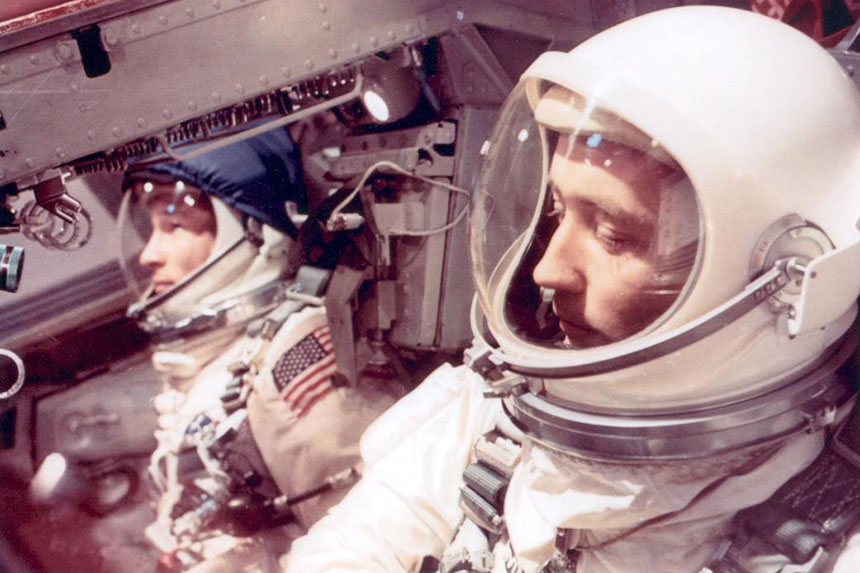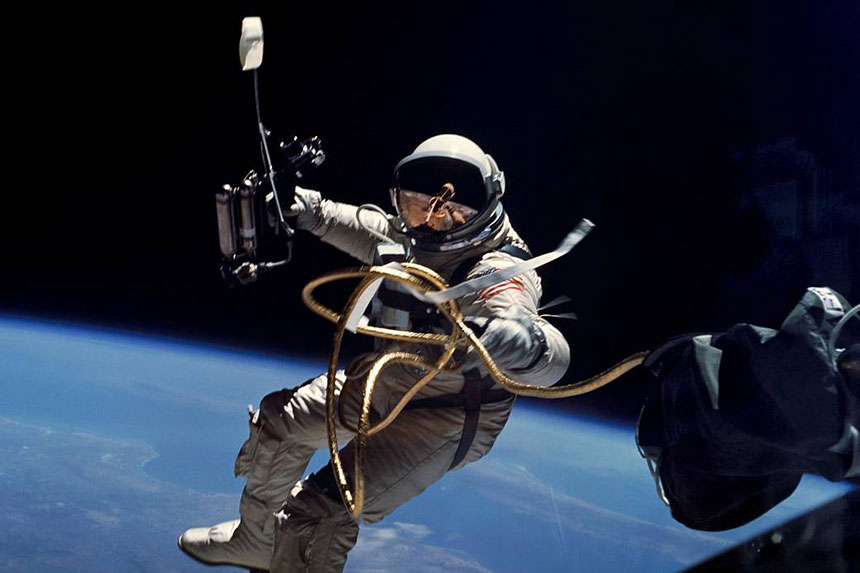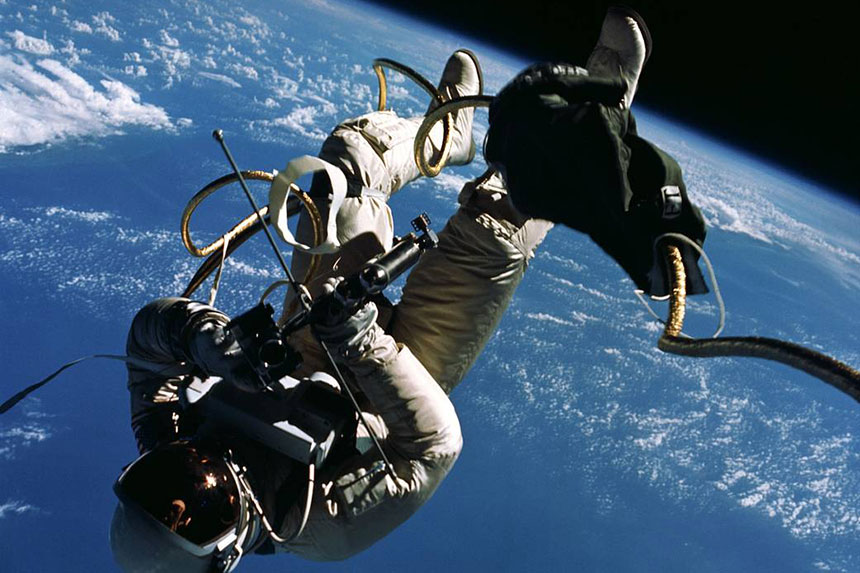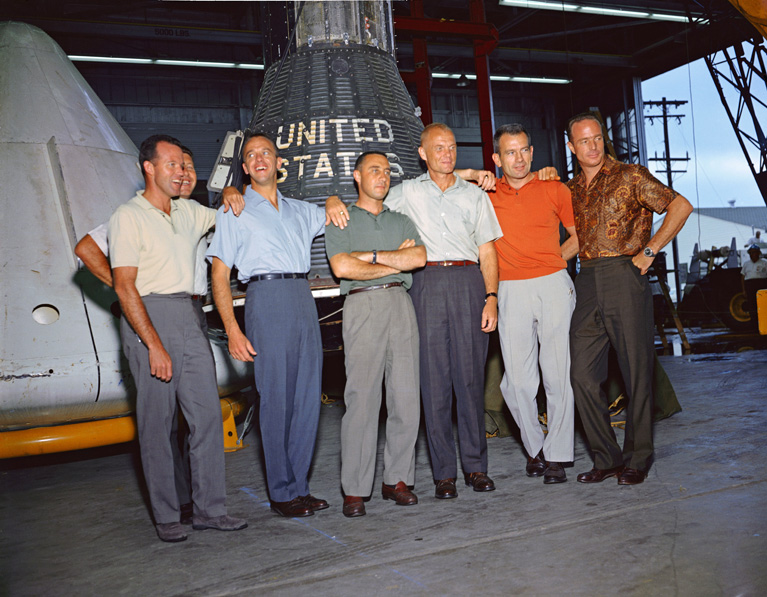Astronaut Ed White Walks Among the Stars
In 36 short years, Ed White lived a life of adventure and distinction. A West Point grad, an aeronautical engineer, a fighter pilot, and a test pilot, White pushed himself toward the goal of becoming one of America’s astronauts. While serving as Pilot of Gemini IV, White managed to take his exceptional and pioneering life one step further by becoming the first American to conduct a spacewalk.
Ed White had flight in his blood. His father was a U.S. Air Force major general who took Ed up in a T-6 training craft when the boy was 12; he even allowed Ed to take the controls. That was it for the younger White; as he told Newsweek in 1965, the act of flying “felt like the most natural thing in the world to do.” White later went to West Point where he excelled as an athlete; he missed making the 1952 U.S. Olympic Team in hurdles by fractions of a second. After graduating West Point, he entered the Air Force.
White earned his flight wings by 1953. While at the 22nd Fighter Day Squadron in West Germany, he flew NATO missions in both the F-86 and F-100 Sabre squadrons. In 1957, while learning about America’s nascent space program, White decided to become an astronaut. To pursue that, he earned an aeronautical engineering degree at the University of Michigan and followed that up by earning his test pilot credentials at USAF Test Pilot School at Edwards Air Force Base. White was one of the pilots who flew planes to simulate weightlessness. Eventually becoming a Lieutenant Colonel, White was chosen for the second group of astronauts in 1962.

The second series of manned NASA missions was Gemini, and White was selected as pilot for Gemini IV; he would be flying with Command Pilot James McDivitt. The four-day mission began with a launch on June 3, 1965. The flight would be attempting two firsts: the first space rendezvous between two crafts and the first Extra-Vehicular Activity, more commonly known as an EVA or spacewalk. The Soviet space program had pulled off an EVA earlier in the year, and NASA was eager to do it better. On the mission’s first orbit after reaching space, Gemini IV attempted to reconnect with the Titan II rocket that had provided the spacecraft’s lift-off. Unfortunately, they were not able to make the rendezvous and that action was abandoned.

As the craft continued to circle the Earth, White prepared for his spacewalk. White exited the vehicle, connected to the ship by a tether. For moving about, he used a Hand-Held Maneuvering Unit, which expelled bursts of air to push him around in weightlessness. The 20-minute session was widely hailed as a success and paved the way for more regular usage of EVAs through the Gemini program and beyond. White and McDivitt also conducted a number of experiments during the mission, including the measurement of radiation in the craft. Although the mission was shooting for five days, a computer failure forced them to return to Earth a day early. Nevertheless, it was an overall success and pictures of White’s spacewalk were seen around the world.

Sadly, the story of Ed White has a tragic coda. White was selected to fly on Apollo I with Virgil “Gus” Grissom and Roger Chaffee. During a test in the Apollo capsule on Launch Pad 34 at Cape Kennedy on January 27, 1967, a spark caused a fire. In the oxygen-rich environment of the sealed capsule, the blaze was almost instantly lethal. All three astronauts were killed. White was interred at West Point Cemetery; over the years, he posthumously received a number of honors, including the Congressional Space Medal of Honor.
Today, EVAs occur as a matter of course in space operations. The work done by White led to a two-hour spacewalk by Buzz Aldrin later in the Gemini program. Astronauts now use a variety of sophisticated equipment, such as the jet-pack-like Manned Maneuvering Units, to execute these operations. The longest spacewalk on record occurred in 2001 when Americans Jim Voss and Susan Helms went EVA for just under nine hours. Ed White’s spacewalk made him a trailblazer, but his exceptional life of committed service made him an American hero.
Featured image: Ed White makes his historic spacewalk. (NASA.gov)
How America Almost Lost the Space Race
In 1962, a top scientist at NASA declared that landing a man on the moon would be “the most dramatic physical event in history.”
His assessment was shared by many, including President Kennedy. So it was no surprise that America poured millions into its space program. And no surprise that getting to the moon became a contest between the U.S. and its ideological rival: the U.S.S.R.
The Cold War was heading to outer space.
The American space program had Wernher von Braun, the former Nazi officer who had developed the V-2 rocket that terrorized London in World War II. By capturing him and putting him to work on their own rocket program, the United States’ space program took a giant step forward.
However, the Russians had Sergei Korolev. As early as 1933, he was launching rockets for the Soviets. But the Russian program fell behind in 1938, when Korolev was sentenced to a Gulag on charges of being “anti-Soviet.” After six years, he was released and sent to work with the German rocket scientists being rounded up by the Red Army. Three years later, he successfully launched the R-2, Russia’s version of the V-2 rocket.
Meanwhile, the Americans, under von Braun’s direction, were launching V-2 replicas in the New Mexico desert.
The Russians began pulling ahead. Under Korolev’s direction, they started developing multi-stage payloads to give their rockets more power and versatility. By 1949, they had extended the range of their rockets to 186 miles. By 1957, their missiles could fly over 4,000 miles and deliver a payload — like a nuclear bomb — weighing up to five tons. They could also — in theory — send men into orbit around the earth.
Then, on October 4, 1957, came the announcement that shocked America. The Soviets had launched a missile with a thrust over six times greater than any U.S. missile and sent a satellite into orbit around the world — The Sputnik I.
In an editorial from its November 9, 1957, issue, The Saturday Evening Post declared, “Nobody but an idiot would declare that Russia’s Sputnik is just a stunt without military significance. Plainly the Soviet Union’s success in launching this satellite carries enormously important implications, among them the possibility that the Reds will be able presently to unload devastating missiles upon this country.”

Officials in Washington had been closely monitoring the Soviet space program. They realized that the Russians now had the capability to launched a nuclear warhead onto American soil. Just as important, the success of the Sputnik launch had diminished American technology and expertise in the eyes of the world.
Sputnik put new urgency in the U.S. space program. Unfortunately, American prestige suffered a further setback in December 6, 1957, when the launch of a U.S. Vanguard rocket, televised live to the nation, failed spectacularly.
The failed Vanguard rocket launch on December 6, 1957 (Uploaded to YouTube by NASA Langley CRGIS)
In 1959, Russia launched the first space probe to reach the moon. And in 1961, they put the first man in space when cosmonaut Yuri Gagarin orbited the earth.
So it isn’t surprising to see a Post author in 1962 asking “Can We Still Be the First on the Moon?” The answer, according to author Don A. Schanche was not “particularly reassuring.”
The Soviet rockets were, he wrote, considerably more powerful. They were developed with the goal of doing the heavy lifting to carry nuclear bombs to the U.S. Meanwhile American scientists focused on launching lightweight satellites. Rather than developing more powerful rocket engines, the U.S. team spent their time on miniaturizing its space equipment.
Now NASA turned its attention to developing more powerful booster engines, like the Titan and Saturn series. But this still wouldn’t let the Americans catch up, Schanche wrote. Russians were within a month of being able to link up two space vehicles, something America wouldn’t achieve until 1966.
What Schanche couldn’t have foreseen was that the U.S. space program would build up momentum by 1965. In the following two years, it accomplished its first spacewalk, first spacecraft orbit change, an eight-day spaceflight, a 14-day spaceflight, and the first spacecraft docking.

And that linkup between two Russian space craft expected in 1962? It didn’t occur for another five years.
The two countries’ space programs underwent a reversal of fortune in 1966, when Sergei Korolev died suddenly. There was no competent successor. The next Soviet manned rocket, launched the next year, resulted in the first cosmonaut’s death in Russia’s space program. Russia’s moon landing, planned to celebrate the 50th anniversary of the Bolshevik Revolution, never took place.
With the Apollo 11 mission safely returning from the moon, the Americans declared the space race over and won. Seeing America’s advances, the Soviet program switched its efforts to building space stations.

The contest over, at least to American satisfaction, the way was clear for cooperation instead of competition. Six years after the moon landing, in 1975, America linked up its Apollo space craft with the Russian Soyuz space station 18 for the first international space mission.

Featured image: Apollo 11 mission control celebrates. (NASA)
Mercury 7: America’s First Space Force
After all, the right stuff was not bravery in the simple sense of being willing to risk your life (by riding on top of a Redstone or Atlas rocket). Any fool could do that (and many fools would no doubt volunteer, given the opportunity), just as any fool could throw his life away in the process. No, the idea (as all pilots understood) was that a man should have the ability to go up in a hurtling piece of machinery and put his hide on the line and have the moxie, the reflexes, the experience, the coolness, to pull it back at the last yawning moment.
-Tom Wolfe, The Right Stuff
Instant cultural icons. American heroes. The best of the best. Those are just a few of the superlatives associated with the seven men that NASA introduced to the country 60 years ago this week: our first astronauts.
The Space Race between the United States and the Soviet Union began in earnest with the launch of Sputnik on October 4, 1957. President Dwight D. Eisenhower proposed the creation of NASA; by the fall of 1958, NASA would absorb previous programs and departments dedicated to space travel, including NACA (National Advisory Committee for Aeronautics) and the U.S. Air Force’s Man in Space Soonest (MISS) effort. Then the Russians launched a second Sputnik, this one carrying a dog, Laika. It became even more of an imperative for the U.S. to get a man into space. That effort would be dubbed Project Mercury.
Mercury’s goal was to put an astronaut into space in a single-person spacecraft. The astronaut would be seated in a capsule mounted atop a rocket modified from Redstone and Atlas missiles. After achieving orbital or suborbital flight, the capsule would make re-entry and be retrieved in the ocean. Many of the functions necessary for flight would be controlled from NASA on the ground with the astronauts making adjustments and performing other tasks in flight. Despite an abundance of caution undertaken by expert engineers, this kind of mission would obviously still be extremely dangerous. How do you recruit for that?

NASA decided to use military test pilots, both for their familiarity with operational security and their reputation for fearlessness in potentially dangerous situations. The specifications drawn up by the search committee also required that candidates possess a bachelor’s degree, be a graduate of test pilot school, and be a flight-qualified jet pilot with more than 1,500 hours of flying time logged. They also had to be in outstanding physical condition to withstand the rigors of spaceflight, notably the gravitational forces that act on the body during both the launch and re-entry phases.
More than 500 pilots comprised the first pool, which was winnowed down to 110. After Pentagon and NASA briefings, written tests, physical examinations, and adherence to height and age requirements, the pool dropped to 32. The group experienced a variety of medical and psychological tests and physical challenges that ran from the strenuous (hours on treadmills) to the strange (candidates were given five enemas). .Robert R. Gilruth, Director of NASA’s Space Task Group, selected the final seven. The so-called Mercury Seven were Alan Shepard, Virgil “Gus” Grissom, John Glenn, Wally Schirra, Scott Carpenter, Deke Slayton, and Gordon Cooper.
The group had a laundry list of accomplishments as military pilots; many of them flew combat missions in World War II or Korea (Grissom flew 100 combat missions during the conflict, and Schirra flew 90). Glenn had already made history by making the first supersonic transcontinental flight across the U.S. As a group, they were dizzyingly qualified. In fact, the overall candidate pool was of such a high caliber that a number of astronauts that didn’t make the first round were invited into later programs, including Pete Conrad (eventually the third man to walk on the Moon) and Jim Lovell (who famously commanded Apollo 13).
NASA formally introduced the astronauts in Washington, D.C., on April 9, 1959, to a crowd of 200 reporters. Virtually unknown, the seven men were hailed as national heroes by the next day, with the press and commentators playing up their roles as daring explorers and new leaders in an ideological race to hold the line against the Soviets in outer space. The press immediately praised the group as “ seven men cut of the same stone as Columbus, Magellan, Daniel Boone, Orville and Wilbur Wright,” but they proved to be refreshingly normal. Asked about the worst part of the medical testing, Glenn said, “If you figure out how many openings there are in the human body, and how far you can go into any one of them, you can answer which would be the toughest for you.” Their “regular guy” demeanor in terms of how humbled they were about their selection only furthered their popularity.

Behind the scenes, the Mercury Seven became instrumental team members for the ultimate planning and design of the missions. Despite having some of the greatest minds in aeronautics and rocketry on staff, the astronauts were welcomed in to contribute from their own areas of expertise. Each astronaut had an impact on systems and design based on their own personal experiences. Grissom, for example, held an engineering degree from Purdue University, and was involved in working on the attitude control systems. Carpenter came in with an interesting skillset that included airborne electronics and the extremely appropriate art of celestial navigation, which is the practice of using the stars to find your way; he was a natural for taking responsibility for the communications and navigation systems.
The Mercury Seven and the “space race” became an ongoing source of general fascination for the next few years, bolstered in part by president John Kennedy’s enthusiasm for the program and his vision of a “New Frontier.” Alan Shepard was selected to be the first American in space; the U.S. might have beaten the Soviets on that front, but Shepard’s mission was plagued by delays. On April 12, 1961, cosmonaut Yuri Gargarin made the journey first, and also became the first man to orbit the Earth. Shepard finally got the go-ahead on May 5, 1961, and became the second person, and first American, in space.
Over the years that followed, the Seven continued to make their mark at NASA. Grissom unfortunately died in the launchpad fire that occurred on Apollo 1, but the other six lived into the 1990s and beyond, taking part in acts of bravery and distinction. All of the men eventually made it into space, with some going multiple times. Cooper was the last man to fly in space alone. Shepard went to the Moon as commander of Apollo 14. Glenn flew on Space Shuttle Discovery at the age of 77 while he was a sitting U.S. Senator. Carpenter also took part in the Navy’s SEALAB deep-ocean habitat projects. Wally Schirra flew as part of the Mercury, Gemini, and Apollo series of missions. Slayton was the first Chief of the Astronaut Office before becoming Director of Flight Crew Operations.
Tom Wolfe’s book on the space program, The Right Stuff, talks about the intangibles that reside inside the best of us. The Mercury Seven were real people, and by definition, real people can’t be perfect. But they represented a grander American ideal of trailblazing and ingenuity. They represented the triumphs of science and teamwork. If you’re ever asked to point to a person that showed what the promise of Kennedy’s “New Frontier” looked like, it’ll be easy. You’ve got seven.
Featured Image (in space suits): The Mercury Seven on April 9, 1959 (Front row, left to right: Walter M. Schirra, Jr., Donald K. “Deke” Slayton, John H. Glenn, Jr., and M. Scott Carpenter; back row, Alan B. Shepard, Jr., Virgil I. “Gus” Grissom, and L. Gordon Cooper, Jr.) (NASA)